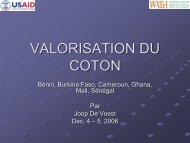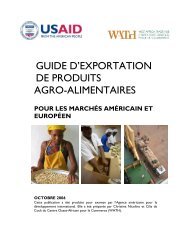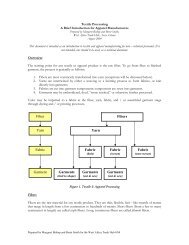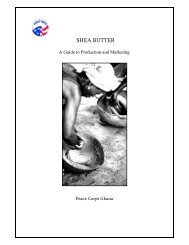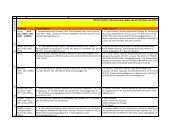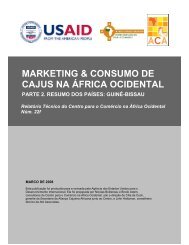A Value Chain Analysis of the Cashew Sector - AGOA Export Toolkit
A Value Chain Analysis of the Cashew Sector - AGOA Export Toolkit
A Value Chain Analysis of the Cashew Sector - AGOA Export Toolkit
You also want an ePaper? Increase the reach of your titles
YUMPU automatically turns print PDFs into web optimized ePapers that Google loves.
2.5 Gender Aspects and <strong>the</strong> Poverty Relevance<br />
<strong>of</strong> <strong>Cashew</strong> Processing<br />
Poverty in Ghana is concentrated in rural areas and impacts<br />
women more severely than men. Th e poverty rate for nor<strong>the</strong>rn<br />
savannah areas is signifi cantly higher than <strong>the</strong> national<br />
average. Th e Nor<strong>the</strong>rn, Upper East and Upper West Regions<br />
are generally <strong>the</strong> poorest in Ghana, followed by <strong>the</strong> Volta Region<br />
(GLSS, 2006). Both <strong>the</strong> incidence and depth <strong>of</strong> poverty<br />
are found to be greater in <strong>the</strong> rural savannah than in any o<strong>the</strong>r<br />
area. Th e proportion <strong>of</strong> Ghanaians described as being “poor”<br />
decreased to 28.5% in 2005/06 from 39.5% in 1998/1999.<br />
Th ose considered “extremely poor” declined to 18.2% from<br />
26.8%. All localities in Ghana with <strong>the</strong> exception <strong>of</strong> Greater<br />
Accra and <strong>the</strong> Upper West Region have experienced a decline<br />
in poverty.<br />
Th e Poverty Impact Assessment conducted by GTZ revealed<br />
that women (heads <strong>of</strong> households, single and married), show<br />
signifi cant interest in working in existing cashew processing<br />
companies. Based on <strong>the</strong> discussions held with women actually<br />
working in processing companies, it seems that this type<br />
<strong>of</strong> employment is preferred to <strong>the</strong> hard labour associated with<br />
cashew production and o<strong>the</strong>r agricultural activities. Consequently,<br />
processing jobs are a favoured alternative way <strong>of</strong> earning<br />
income for women in rural communities.<br />
There is no apparent division <strong>of</strong> labour based on gender in<br />
cashew production, apart from regarding thinning and pruning,<br />
which are almost always done by men. Activities such as<br />
weeding, clearing, planting and sowing are undertaken by both<br />
women and men, albeit in diff erent proportions. In some<br />
cashew producing communities, women make juice and alcohol<br />
from cashew apples, and are <strong>the</strong>refore highly involved in <strong>the</strong><br />
processing <strong>of</strong> apples and nuts at <strong>the</strong> household level. Fur<strong>the</strong>rmore,<br />
70% <strong>of</strong> <strong>the</strong> labour force involved in processing activities<br />
is comprised <strong>of</strong> women (CDP, 2009c), and many women participate<br />
in <strong>the</strong> selling <strong>of</strong> raw nuts at marketing centres. How ever,<br />
large traders/exporters and <strong>the</strong>ir agents generally tend to be men.<br />
In <strong>the</strong> nor<strong>the</strong>rn part <strong>of</strong> <strong>the</strong> country, some farmers use income<br />
gained from cashew production to establish livestock enterprises<br />
(PPMED, 2007). While <strong>the</strong>re is a progressive trend towards<br />
more inclusion <strong>of</strong> perennial tree crops (cocoa, citrus,<br />
rubber, cashew, mango) in farming systems, most farm-based<br />
households maintain traditional multiple sources <strong>of</strong> income -<br />
each has on average 7-8 income sources (PPMED, 2007).<br />
Th is strategy aims to reduce economic and production risks<br />
by allowing for agricultural seasonality and increased use <strong>of</strong><br />
labour during <strong>the</strong> course <strong>of</strong> <strong>the</strong> year. However, it usually involves<br />
limited labour productivity for those households in <strong>the</strong><br />
poor and medium categories, and also restricts <strong>the</strong> labour and<br />
capital investments needed for intensive commercial agriculture<br />
and specialisation (PPMED, 2007).<br />
<strong>Cashew</strong> farming can lead to increased employment opportunities<br />
for women in rural areas (processing companies), and<br />
generate income for vulnerable smallholder farmers and women.<br />
All <strong>the</strong>se opportunities will ultimately result in an improvement<br />
in rural living conditions, and hence contribute to poverty<br />
reduction.<br />
27



